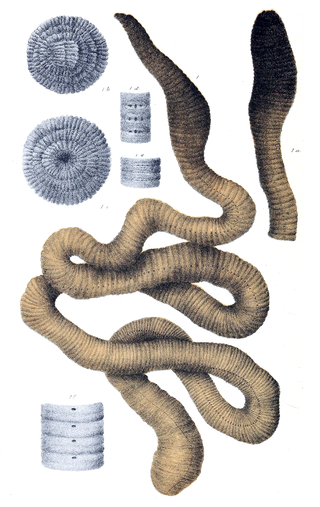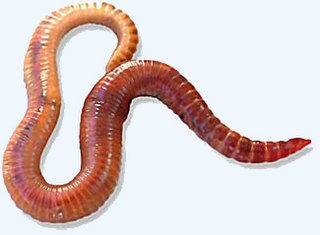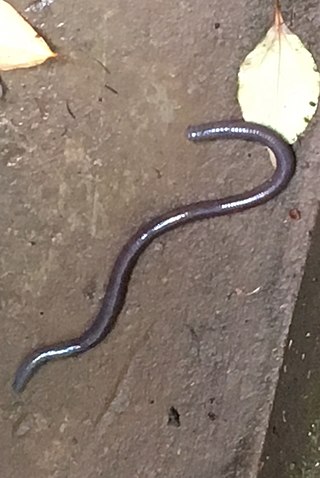
Lumbricus terrestris is a large, reddish worm species thought to be native to Western Europe, now widely distributed around the world. In some areas where it is an introduced species, some people consider it to be a significant pest for out-competing native worms.

The Lumbricidae are a family of earthworms. About 33 lumbricid species have become naturalized around the world, but the bulk of the species are in the Holarctic region: from Canada and the United States and throughout Eurasia to Japan. An enigmatic species in Tasmania is Eophila eti. Currently, 670 valid species and subspecies in about 42 genera are recognized. This family includes the majority of earthworm species well known in Europe and Asia.

Oligochaeta is a subclass of soft-bodied animals in the phylum Annelida, which is made up of many types of aquatic and terrestrial worms, including all of the various earthworms. Specifically, oligochaetes comprise the terrestrial megadrile earthworms, and freshwater or semiterrestrial microdrile forms, including the tubificids, pot worms and ice worms (Enchytraeidae), blackworms (Lumbriculidae) and several interstitial marine worms.

Megascolecidae is a family of earthworms native to Madagascar, Australia, New Zealand, Asia, and North America. At up to 2 meters in length, their large size distinguishes the Megascolecidae from other earthworm families. They are an essential part of maintaining soil structure, minor carbon sequestration, and maintaining terrestrial ecosystems.

The giant Gippsland earthworm is one of Australia's 1,000 native earthworm species.

Lumbricus rubellus is a species of earthworm that is related to Lumbricus terrestris. It is usually reddish brown or reddish violet, iridescent dorsally, and pale yellow ventrally. They are usually about 25 millimetres (0.98 in) to 105 millimetres (4.1 in) in length, with around 95–120 segments. Their native distribution was mainland Europe and the British Isles, but they have currently spread worldwide in suitable habitats.

Eisenia fetida, known under various common names such as manure worm, redworm, brandling worm, panfish worm, trout worm, tiger worm, red wiggler worm, etc., is a species of earthworm adapted to decaying organic material. These worms thrive in rotting vegetation, compost, and manure. They are epigean, rarely found in soil. In this trait, they resemble Lumbricus rubellus.

The Clitellata are a class of annelid worms, characterized by having a clitellum – the 'collar' that forms a reproductive cocoon during part of their life cycles. The clitellates comprise around 8,000 species. Unlike the class of Polychaeta, they do not have parapodia and their heads are less developed.

The rough-haired golden mole is a species of mammal that live mostly below ground. They have shiny coats of dense fur and a streamlined, formless appearance. They have no visible eyes or ears; in fact, they are blind - the small eyes are covered with hairy skin. The ears are small and are hidden in the animal's fur.

Pheretima is a genus of earthworms found mostly in New Guinea and parts of Southeast Asia.

An earthworm is a soil-dwelling terrestrial invertebrate that belongs to the phylum Annelida. The term is the common name for the largest members of the class Oligochaeta. In classical systems, they were in the order of Opisthopora since the male pores opened posterior to the female pores, although the internal male segments are anterior to the female. Theoretical cladistic studies have placed them in the suborder Lumbricina of the order Haplotaxida, but this may change. Other slang names for earthworms include "dew-worm", "rainworm", "nightcrawler", and "angleworm". Larger terrestrial earthworms are also called megadriles as opposed to the microdriles in the semiaquatic families Tubificidae, Lumbricidae and Enchytraeidae. The megadriles are characterized by a distinct clitellum and a vascular system with true capillaries.

The European nightcrawler is a medium-small earthworm averaging about 1.5 g when fully grown. Generally blueish, pink-grey in color with a banded or striped appearance, the tips of their tails are often cream or pale yellow. When the species has not been feeding, it is pale pink. The species is usually found in deep woodland litter and garden soils that are rich in organic matter in European countries. D. hortensis is sold primarily as a bait worm, but its popularity as a composting worm is increasing.
Earthworms are invasive species throughout the world. Of a total of about 6,000 species of earthworm, about 120 species are widely distributed around the globe. These are the peregrine or cosmopolitan earthworms. Some of these are invasive species in many regions.

Dendrodrilus rubidus is a species of earthworm in the family Lumbricidae. It is native to Europe, and it is a widespread introduced species, occurring on every continent except Antarctica, as well as many islands. It is often invasive. It is sometimes used as fishing bait, and is marketed under many nonspecific names, including red wiggler, jumping red wiggler, red trout worm, jumbo red worm, and pink worm. Other common names include bank worm, tree worm, and gilt tail.
Samuel James is an American scientist, a researcher specializing in evolutionary biology, focusing on earthworm taxonomy. James, with fellow researchers, has discovered numerous species of annelids, including Diplocardia californiana, Diplocardia woodi, Diplocardia montana, and a new species related to the Giant Palouse earthworm.
Octochaetus multiporus, commonly known as the New Zealand earthworm, is a megascolecid worm endemic to New Zealand. It is mainly found in the south of Manawatu but may also be found along the east coast of the South Island. A bioluminescent worm, Octochaetus multiporus secretes a luminescent fluid from its mouth when disturbed or punctured.

Aporrectodea caliginosa is an earthworm commonly found in Great Britain. It is recognizable by the three distinct shades of colour at its front end, and it is 6 centimetres (2.4 in) in length when not moving. Its saddle pads usually form a two humped ridge across three segments along the length of the saddle, however this is not clearly visible. The worm mostly lies in non-permanent horizontal burrows in topsoil, and is rarely found in leaf litter. Like most worms, its diet consists only of soil.

Octolasion lacteum is a species of earthworm of the genus Octolasion. In New Zealand it has been found in West Coast soils and in Canterbury. They are found in mostly moist areas deep under the soil as they feed in the nutrients within the soil. Unlike other worm species, these are known to survive in acidic soil as well as soil that is not as organic compared to other places. They provide some important roles in the ecosystem as well as threats to other species as well. After a drought, they help the soil get more organic by adding more carbon dioxide in the soil and the waste from the O. lacteum also provides nutrients for the soil. In another case, they can also be invasive in a way that they suck up carbon in the soil which means plants have less causing a disruption to the food web. Lastly, they reproduce by cross parthogenic reproduction.
Komarekiona eatoni, or the Kentucky earthworm, is a terrestrial species of nearctic Annelid found in the southwestern United States, especially near the Appalachian Mountains. Komarekionidae is one of the few endemic Megadrile families in North America north of Mexico.













